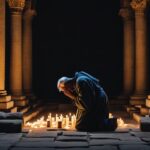Prayer in visual arts has long been a source of inspiration and expression for artists throughout history. It is a powerful tool that allows for the communication of spiritual themes, the exploration of sacred art, and the creation of artistic expressions of prayer. By incorporating meditation in art and utilizing religious symbolism, artists are able to convey the essence of prayer and invite viewers to connect with the divine.
Key Takeaways:
- Prayer in visual arts serves as a means of expressing spiritual themes and exploring sacred art.
- Artistic expressions of prayer often incorporate elements of meditation and religious symbolism.
- Through visual arts, artists create a sense of connectedness and invite viewers to engage in their own moments of reflection.
- Religious symbolism in art acts as a visual language that communicates the deep significance of prayer.
- Prayer in visual arts has the power to evoke emotional and spiritual responses, transcending cultural and religious boundaries.
The Power of Prayer in Visual Arts
Visual arts have a unique ability to convey the essence of prayer through various artistic expressions. Artists utilize religious symbolism and divine inspiration to capture the spiritual and transformative aspects of prayer in their creations. Through their artworks, viewers are invited to connect with the divine in a profound and meaningful way.
Religious symbolism plays a significant role in visual arts, allowing artists to communicate spiritual concepts and evoke a sense of reverence and devotion. From elaborate religious icons to intricate stained glass windows, religious symbolism acts as a visual language that conveys the deep significance of prayer and religious practices.
Divine inspiration plays a pivotal role in the artistic process. Artists often find that prayer helps them channel their spirituality and connect with a higher power, guiding their creative endeavors. This connection with the divine allows artists to produce works that resonate with viewers on a spiritual level, fostering a deep sense of connectedness and contemplation.
| Artistic Expressions of Prayer | Religious Symbolism | Divine Inspiration |
|---|---|---|
| Paintings depicting individuals engaged in prayer | Saints and religious figures represented with specific symbols | Artists channeling their spirituality through prayer |
| Sculptures capturing moments of meditation and reflection | Religious artifacts adorned with symbolic imagery | Prayer as a catalyst for creative ideas and concepts |
| Photographs capturing spiritual experiences and rituals | Architectural elements designed to inspire prayer | Artists seeking divine guidance during the creative process |
“Through artistic expressions of prayer, visual arts have the power to transcend the boundaries of language and culture, allowing individuals from diverse backgrounds to connect with the divine in a universal way.”
By harnessing the power of prayer, artists are able to create visual representations that speak directly to the soul. These artistic expressions of prayer provide viewers with an opportunity for deep introspection, contemplation, and spiritual connection. Through art, the transformative and transcendent qualities of prayer are brought to life, enriching the human experience.
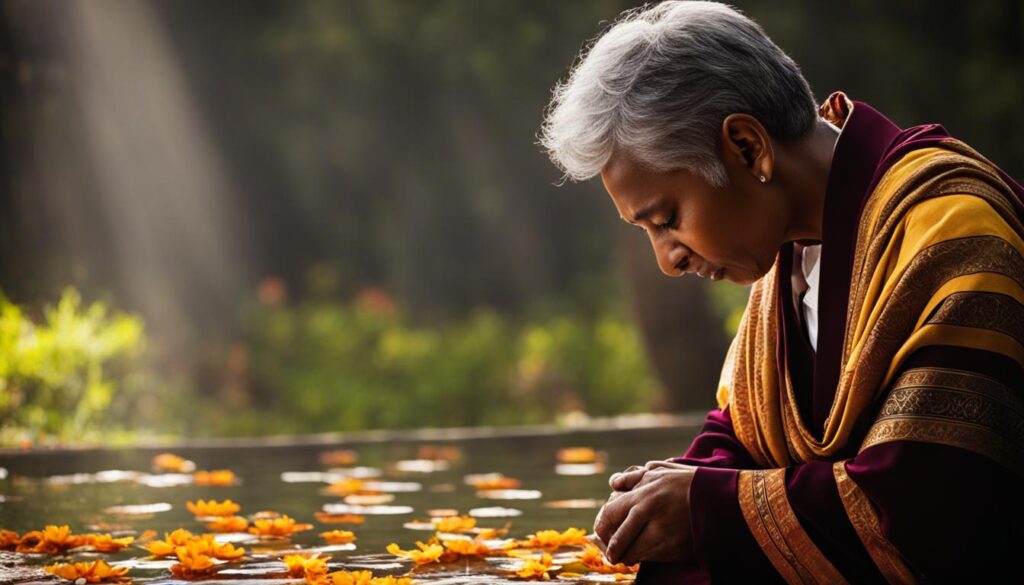
Historical Significance of Prayer in Visual Arts
Throughout history, prayer has played a significant role in the creation of religious art, leaving a lasting impact on both the art world and spiritual practices. Artists have long sought to express their deep spirituality and explore sacred themes through their works, resulting in a rich tradition of religious art that continues to inspire and captivate viewers.
Religious art has served as a visual representation of prayer, allowing believers to deepen their connection with the divine and gain a deeper understanding of their faith. From ancient civilizations to the Renaissance era and beyond, artists have utilized their talents to create breathtaking masterpieces filled with spiritual meaning and devotion.
These artworks have not only served as objects of beauty but also as powerful tools for worship and spiritual reflection. They have provided believers with visual aids for prayer, teaching them how to connect with the divine and inspiring them to cultivate a deeper relationship with their faith. From iconic religious symbols to intricate depictions of spiritual experiences, religious art has been a source of inspiration and devotion for centuries.
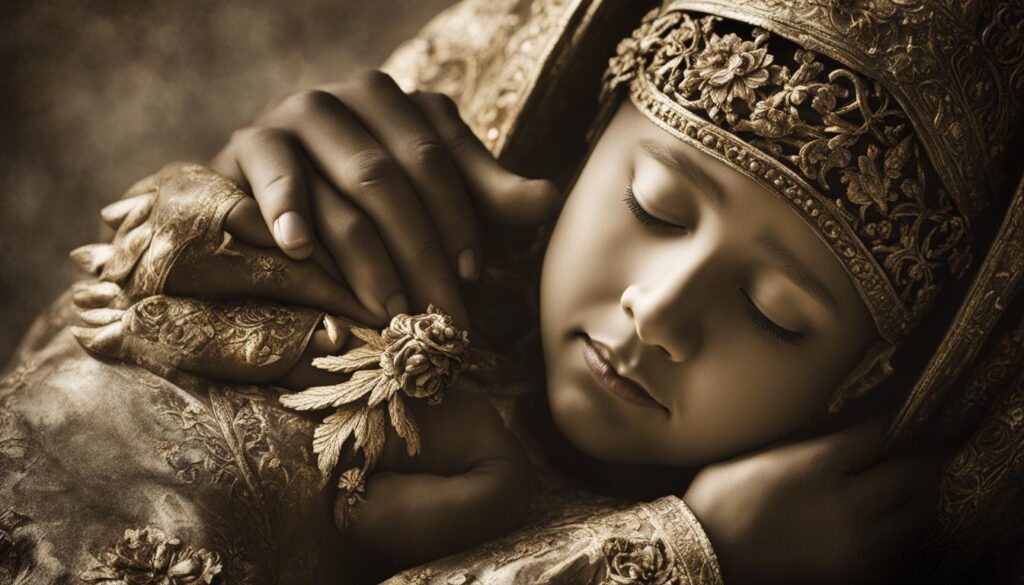
Table: Influence of Prayer in Visual Arts throughout History
| Era | Artistic Movements | Key Themes |
|---|---|---|
| Ancient Civilizations | Egyptian, Greek, Roman | Depictions of deities, religious rituals, divine guidance |
| Medieval Period | Gothic, Byzantine | Crucifixion, Madonna and Child, saints and martyrs |
| Renaissance | Italian Renaissance, Northern Renaissance | Religious narratives, biblical scenes, portraits of religious figures |
| Baroque | Counter-Reformation | Dramatic lighting, emotional intensity, religious symbolism |
| Modern Era | Symbolism, Surrealism, Abstract Expressionism | Exploration of spiritual and metaphysical concepts, individual spiritual experiences |
The influence of prayer in visual arts is not limited to any particular era or artistic movement. It transcends time and continues to be a source of inspiration for artists today. The historical significance of prayer in visual arts reminds us of the enduring power of spirituality and its ability to touch the hearts and souls of both artists and viewers.
The Intersection of Prayer and Meditation in Art
Prayer and meditation have long been intertwined in the realm of visual arts, with artists incorporating elements of meditation into their creative process to create works of art that serve as visual prayers. Through their art, they seek to establish a connection between the viewer and the spiritual realm, inviting contemplation and reflection.
By incorporating meditation in art, artists can tap into a state of deep focus and awareness, allowing their creative process to become a form of prayer. As they engage in the act of creation, they channel their spirituality and connect with the divine, infusing their artwork with a sense of sacredness and meaning. The resulting pieces are often imbued with a sense of tranquility and contemplation, inviting viewers to enter into a meditative state as they engage with the artwork.
Visual prayers, as these artworks are often referred to, offer a unique way for individuals to connect with their spirituality through art. As viewers engage with these visual prayers, they have the opportunity to enter into a dialogue with the divine. The symbolism, colors, and compositions used in these artworks can evoke powerful emotions and facilitate a deep sense of connectedness with the spiritual realm.
The Role of Meditation in Artistic Creation
Artists often turn to meditation as a means to find inspiration and guidance in their creative process. Through meditation, they are able to quiet their minds, access their inner creativity, and tap into a state of receptivity that allows them to channel their artistic ideas and visions. The practice of meditation allows artists to go beyond the surface level and tap into a deeper well of creativity and intuition.
Meditation also allows artists to cultivate a sense of presence and mindfulness, helping them to fully immerse themselves in the present moment as they create their artwork. This deep level of presence allows for a greater connection with the artwork and a more authentic expression of their spiritual beliefs and experiences.
By incorporating elements of meditation in their artistic process, artists are able to infuse their artwork with a sense of peace, serenity, and transcendence. The resulting pieces serve as visual prayers, inviting viewers to engage in their own moments of meditation and reflection as they contemplate the spiritual themes and symbolism portrayed.
Overall, the intersection of prayer and meditation in art offers a profound way for individuals to connect with their spirituality and engage with the divine. Through visual prayers, artists create a space for contemplation and reflection, inviting viewers on a journey of self-discovery and spiritual connection. By incorporating elements of meditation in their artistic process, artists are able to create works of art that transcend the physical realm and touch the depths of the soul.
Exploring Religious Symbolism in Visual Arts
Religious symbolism plays a significant role in visual arts, offering artists a powerful means to convey spiritual concepts and evoke a sense of reverence and devotion. Through the use of symbols, artists create visual representations that communicate the deep significance of prayer and religious practices. These symbols act as a visual language that transcends cultural and language barriers, inviting viewers to engage with and contemplate the divine.
In religious art, symbols such as the cross, dove, and lotus flower hold profound meaning and serve as reminders of spiritual truths. Each symbol carries its own unique significance, representing aspects of faith, hope, love, and connection to the divine. For example, the lotus flower is a symbol of spiritual purity and enlightenment in Buddhism, while the cross represents the sacrifice and redemption in Christianity.
“Religious symbols in visual arts not only serve as decorative elements but also function as catalysts for spiritual experiences. They prompt viewers to reflect on their own beliefs, values, and experiences, and can inspire a deep sense of awe and wonder.”
Artists skillfully incorporate religious symbolism into their works, creating a visual tapestry of faith and spirituality. Whether through intricate religious icons, stained glass windows, or expressive paintings, these symbols invite viewers to engage in a dialogue with the sacred. The use of religious symbolism in visual arts fosters a deeper connection to the divine, allowing individuals to experience a sense of transcendence and spiritual enlightenment.
Table: Examples of Religious Symbols in Visual Arts
| Symbol | Religious Tradition | Meaning |
|---|---|---|
| Lotus flower | Buddhism | Spiritual purity and enlightenment |
| Cross | Christianity | Sacrifice and redemption |
| Ankh | Ancient Egyptian | Eternal life and vitality |
| Star and crescent | Islam | Divine guidance and protection |
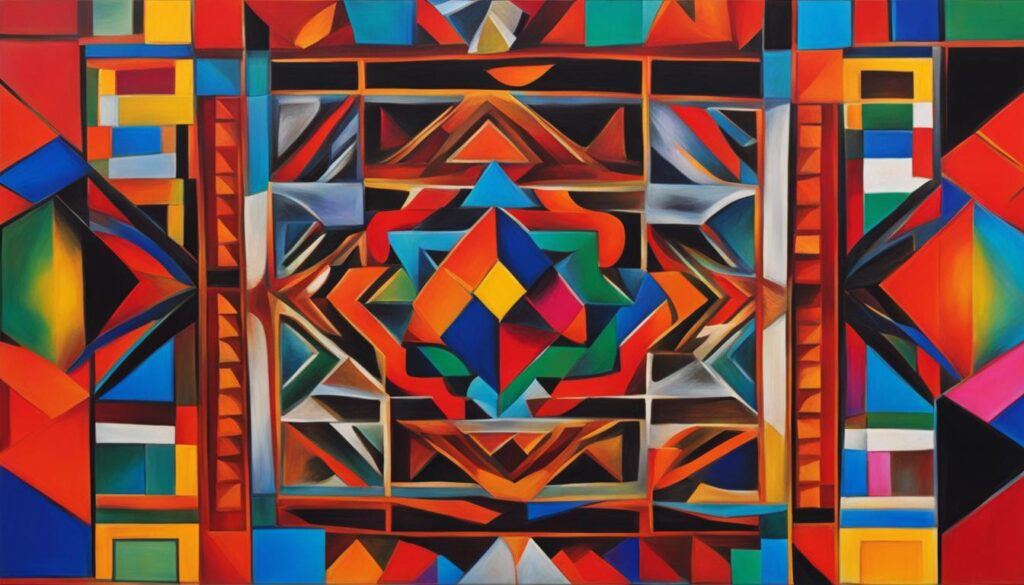
By exploring religious symbolism in visual arts, viewers can gain a deeper understanding of different religious traditions and their beliefs. These symbols serve as gateways to spiritual experiences, prompting individuals to reflect on their own spirituality and the interconnectedness of humanity.
In conclusion, religious symbolism in visual arts serves as a powerful tool for artistic expressions of prayer. Through the use of symbols, artists create a visual language that transcends cultural and religious boundaries, inviting viewers to engage with the divine and reflect on their own spiritual journey. The presence of religious symbolism in visual arts enriches the artistic experience, evoking powerful emotions and facilitating a deep sense of connection and reverence.
The Role of Divine Inspiration in Artistic Expressions of Prayer
| Artist | Artwork | Divine Inspiration |
|---|---|---|
| Leonardo da Vinci | The Last Supper | “The Lord inspired me to depict this moment of profound prayer and communion.” |
| Michelangelo | The Creation of Adam | “Through prayer, I sought divine guidance to capture the sacred act of God giving life to Adam.” |
| Rembrandt | The Return of the Prodigal Son | “Divine inspiration led me to portray the transformative power of prayer and forgiveness.” |
Divine inspiration plays a pivotal role in the creation of artistic expressions of prayer. Artists, such as Leonardo da Vinci, Michelangelo, and Rembrandt, have attested to the profound influence of prayer on their artistic process. Through prayer, these artists sought guidance and connection with the divine, allowing them to create works that resonate with viewers on a spiritual level.
In his masterpiece, “The Last Supper,” Leonardo da Vinci was inspired by prayer to depict the profound moment of communion between Jesus and his disciples. Michelangelo, in his iconic fresco, “The Creation of Adam,” turned to prayer to capture the sacred act of God giving life to humanity. Similarly, Rembrandt’s painting, “The Return of the Prodigal Son,” was shaped by divine inspiration as he sought to convey the transformative power of prayer and forgiveness.
Through their artworks, these artists invite viewers to experience the depth of prayer and its connection to the divine. The power of prayer in artistic creations lies in its ability to transcend earthly limitations and evoke a sense of connectedness and spirituality. It is through divine inspiration that artists are able to capture the essence of prayer and touch the hearts and souls of their viewers.

Artistic Expressions of Prayer: A Source of Connectedness through Art
“Prayer is the foundation of my creative process, allowing me to establish a deeper connection with the divine and infuse spirituality into my artwork.” – Artist Quote
Artistic expressions of prayer have the profound ability to foster a sense of connectedness in both the artist and the viewer. When artists approach their craft as a form of prayer, they establish a deep connection with the divine and infuse spirituality into their creations. This spiritual connection is then transmitted to the viewer, allowing them to experience a similar sense of connectedness and resonance with the artwork.
Through prayerful engagement with art, viewers are invited to embark on their own personal journey of reflection and contemplation. The artist’s intention, guided by divine inspiration, is translated into visual symbols and metaphors that speak to the viewer’s own spiritual yearnings. This shared experience of prayerful art creates an atmosphere of connectedness, where individuals can find solace, inspiration, and a deeper understanding of their own spirituality.
Prayer in Art: A Universal Language of the Soul
- Artistic expressions of prayer transcend cultural and religious boundaries, speaking to the universal longing for spiritual connection.
- Through prayer in art, individuals from diverse backgrounds can find common ground and a shared language of the soul.
- Art acts as a bridge between different faith traditions, inviting dialogue, understanding, and appreciation for one another’s spiritual journeys.
Prayer in art serves as a universal language of the soul, transcending cultural and religious boundaries. Regardless of one’s background or belief system, art has the power to evoke emotions, stir the spirit, and serve as a conduit for spiritual connection. Through artistic expressions of prayer, individuals from diverse backgrounds can find common ground, fostering a sense of unity and understanding.
Art has the unique ability to bridge gaps and invite dialogue between different faith traditions. By engaging with prayerful art, individuals can gain insight into the spiritual practices and beliefs of others, cultivating empathy and appreciation. Prayer in art acts as a catalyst for deepening our understanding of one another’s spiritual journeys and nourishing a sense of interconnectedness in our diverse world.
Visual Prayers: The Art of Communicating with the Divine
Visual prayers are a profound form of artistic expression that allows individuals to communicate with the divine through the power of visual art. Artists create visual representations of prayers using symbols, colors, and compositions, inviting viewers to engage in a heartfelt dialogue with the sacred. This unique form of artistic expression invokes a deep sense of connectedness and spiritual reflection in both the artist and the viewer.
Through visual prayers, artists can convey the essence of their prayerful experiences and invite viewers to embark on their own spiritual journey. The use of symbols and colors in visual prayers allows for a deeper understanding and connection with the divine, transcending cultural and religious boundaries. The beauty and power of visual prayers lie in their ability to evoke powerful emotions and facilitate a profound sense of spiritual connectedness.
“Visual prayers are like windows to the soul, inviting viewers to contemplate and connect with the divine. Through the use of symbols and artistic techniques, artists can express their deepest prayers and invite others to experience the transformative power of prayer through the medium of art.”
Visual prayers can take various forms, from intricate paintings and sculptures to delicate stained glass windows and mosaic designs. Each artwork carries a unique message and intention, inviting viewers to engage in personal reflection and meditation. By immersing themselves in the beauty of visual prayers, individuals can find solace, inspiration, and a deep sense of connectedness with the divine.
Table: Examples of Visual Prayers in Art
| Artwork | Artist | Description |
|---|---|---|
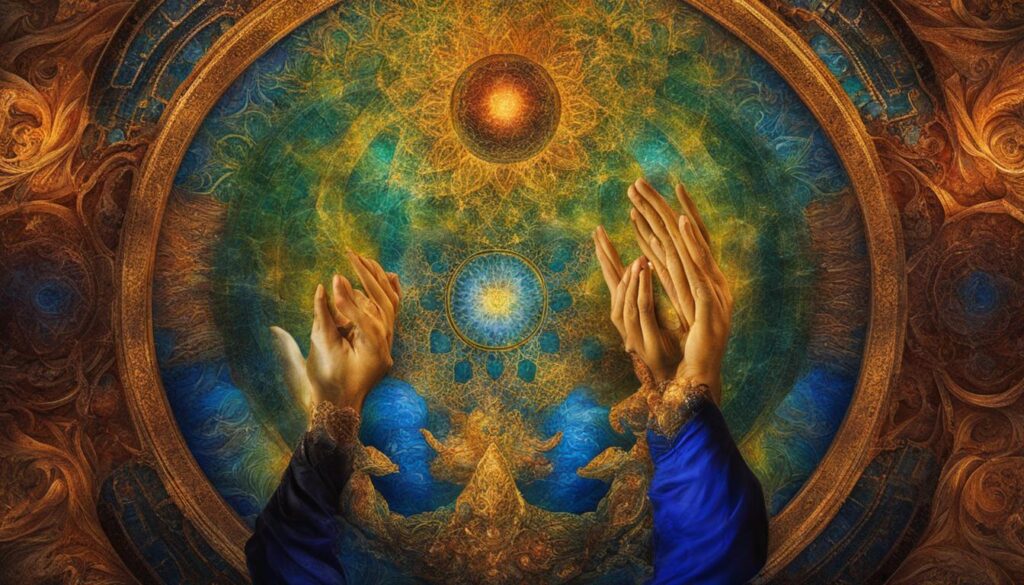 |
Artist Name | A vibrant painting depicting a serene landscape with a figure in prayer, symbolizing a profound connection with nature and the divine. |
 |
Artist Name | A delicate sculpture representing a pair of hands reaching towards the sky, symbolizing a heartfelt prayer for guidance and blessings. |
 |
Artist Name | A stunning stained glass window depicting various religious symbols, inviting viewers to contemplate the beauty of divine presence. |
Visual prayers have the power to transcend language and cultural barriers, allowing individuals from all walks of life to connect with the divine in a universal way. By immersing themselves in the world of visual prayers, viewers can experience a profound spiritual journey and find solace, inspiration, and a deep sense of connectedness with the divine.
The Role of Prayer and Transformative Experiences in Art
Prayer has long been recognized as a transformative practice, allowing individuals to connect with the divine and experience personal growth and enlightenment. In the realm of visual arts, prayer plays a significant role in the creation and appreciation of artworks. Artists who view their creative process as a form of prayer often produce works that resonate on a deeply spiritual level, inviting viewers to embark on their own transformative journeys.
Through prayerful engagement with art, viewers are presented with an opportunity to explore their own spirituality and deepen their understanding of the divine. The act of contemplating prayerful artworks can evoke profound emotions and provoke introspection, enabling individuals to connect with their inner selves and the transcendent. Whether through religious symbolism, divine inspiration, or the use of meditation techniques, prayer in art serves as a gateway to a heightened sense of connectedness.
“Prayer in art is a way for the artist to explore their spirituality and communicate their connection with the divine. It is through this intimate dialogue with the sacred that transformative experiences can occur, both for the artist and the viewer.”
The Power of Divine Inspiration
Divine inspiration plays a pivotal role in prayerful art. Artists who seek a connection to the divine often rely on prayer as a catalyst for their creative process. Through prayer, they open themselves up to receive guidance and inspiration from a higher power, shaping their artistic expressions. This divine intervention infuses their works with a spiritual energy that resonates with viewers, enabling them to experience a sense of awe and reverence.
By engaging with prayerful art, individuals can tap into the transformative power of prayer and allow themselves to be transported to a realm beyond the physical. The artwork becomes a conduit for spiritual exploration and self-reflection, inviting viewers to ponder the mysteries of existence and their place within the grand tapestry of life. In this way, prayer and transformative experiences become intertwined, weaving a transformative narrative through the artistic medium.
| Key Elements | Description |
|---|---|
| Religious Symbolism | Artistic expressions of prayer often incorporate religious symbolism, which serves as a visual language to convey spiritual concepts and evoke a sense of devotion. |
| Divine Inspiration | Artists draw on divine inspiration through prayer, allowing their creations to be infused with a spiritual energy that resonates with viewers. |
| Connectedness Through Art | Prayerful art creates a space for viewers to connect with their spirituality, fostering a sense of connectedness with the divine and the world around them. |
Prayer and transformative experiences in art go hand in hand, offering individuals a profound opportunity for spiritual growth and connection with the divine. Through prayerful engagement with artworks, viewers can embark on a transformative journey, exploring their inner selves and their relationship with the sacred. Art that embodies prayer becomes a bridge between the human and the divine, inviting us to pause, reflect, and experience the transformative power of prayer.
Prayer in Modern-Day Visual Arts
In the realm of modern-day visual arts, prayer continues to be a prominent theme that artists explore through their creations. Through various mediums and techniques, artists express their own spiritual journeys and invite viewers to reflect on their own connection with the divine.
One artistic expression of prayer that has gained momentum in recent years is the use of mixed media installations. Artists incorporate elements such as sacred objects, symbolic imagery, and interactive components to create immersive experiences that evoke contemplation and introspection. These installations often invite viewers to actively engage with the artwork, encouraging a personal and introspective dialogue with the divine.
“Art is the highest form of hope.” – Gerhard Richter
Additionally, contemporary artists are increasingly using digital platforms as a means to explore prayer in visual arts. Through digital art, artists can experiment with new forms of expression and create interactive experiences that transcend physical boundaries. This allows for a wider audience to engage with prayerful art and be part of a global dialogue around spirituality and connectedness through art.
The Evolution of Prayerful Art
Over the years, the evolution of prayerful art has been influenced by societal shifts and cultural changes. Artists are no longer confined to traditional religious themes but instead, they draw inspiration from diverse spiritual traditions and explore personal interpretations of prayer. This has resulted in a rich tapestry of artistic expressions that reflect the complexities of spirituality in the modern world.
| Artist | Artwork | Medium |
|---|---|---|
| Yayoi Kusama | Infinity Mirrored Room – The Souls of Millions of Light Years Away | Mixed media installation |
| Bill Viola | Four Hands | Video installation |
| Marina Abramović | The Artist is Present | Performance art |
These contemporary artworks challenge traditional notions of prayer and push the boundaries of what is considered sacred. They invite viewers to question and delve deeper into their own understanding of spirituality while fostering a sense of connectedness through art.
As the art world continues to evolve, prayer remains a timeless theme that artists will continue to explore and reinterpret. Through their artistic expressions of prayer, artists create not only beautiful works of art but also opportunities for viewers to engage in meaningful introspection and foster a sense of connectedness with the divine.
The Impact of Prayerful Art on Viewers
Prayerful art has the remarkable ability to deeply impact viewers, transcending cultural and religious boundaries, and evoking profound emotional and spiritual responses. By engaging with art that embodies prayer, individuals have the opportunity to experience a sense of connectedness, find solace in the divine, and engage in moments of meditation and reflection.
Through the power of artistic expressions of prayer, viewers can be transported to a realm beyond the tangible, where they can connect with their own spirituality and explore the depths of their emotions. The visual language of prayerful art speaks directly to the soul, inviting viewers to contemplate and reflect on their own beliefs, values, and experiences.
Just as prayer is a personal and intimate experience, the impact of prayerful art is deeply personal as well. Each individual brings their own unique perspectives, experiences, and emotions to the viewing process, allowing for a multitude of interpretations and responses. This diversity of engagement enriches the overall experience of prayerful art, creating a dynamic and thought-provoking dialogue between the artwork and the viewer.
The Transformative Power of Prayerful Art
Prayerful art has the potential to awaken dormant emotions, provoke introspection, and inspire personal growth. Through the medium of art, viewers can witness the transformative power of prayer, as it invites them to confront their innermost thoughts, confront their fears, and seek guidance and comfort from a higher power.
“Prayerful art has the ability to touch the depths of our being, inviting us to have a conversation with the divine and explore our own spirituality.” – Art Critic
By engaging with prayerful art, viewers are offered a sacred space for reflection, where they can pause, ponder, and seek meaning beyond the realm of everyday life. This contemplative engagement can lead to moments of clarity, inspiration, and healing, as viewers find solace, hope, and renewed faith in the midst of their own personal journeys.
The Universal Language of Prayerful Art
One of the remarkable aspects of prayerful art is its ability to transcend language barriers and communicate directly to the heart and soul of the viewer. Regardless of one’s cultural or religious background, the visual expressions of prayer can tap into the universal human experience, resonating with individuals on a deeply human level.
Through the shared language of symbols, colors, and compositions, prayerful art invites viewers to embark on a journey of self-discovery and spiritual exploration. It speaks to the longing for connection, the quest for meaning, and the yearning for transcendence that is inherent in all human beings.
The Power of Prayerful Art
Prayerful art possesses a unique power to inspire, console, and transform. Its impact is not confined to gallery walls or museum exhibits, but extends into the lives and hearts of those who engage with it. Through prayerful art, viewers can find a source of solace, inspiration, and spiritual connection, making it a profound and meaningful part of the human experience.
The Role of Prayer in Art Appreciation and Interpretation
When it comes to the world of visual arts, prayer plays a significant role in enhancing the process of art appreciation and interpretation. The act of engaging in prayerful contemplation before viewing a piece of art allows individuals to approach it with an open heart and mind, enabling a deeper level of understanding and connection. By immersing themselves in prayer, viewers can unlock the spiritual and artistic significance embedded within the artwork, leading to a more profound appreciation of its message and beauty.
Prayer allows individuals to tap into the spiritual themes and intentions behind the creation of religious art. It acts as a key that unlocks the hidden layers of meaning and symbolism, providing insights into the artist’s perspective and the rich tapestry of the artwork itself. Through prayerful contemplation, viewers can connect with the spiritual essence of the artwork, transcending its physical form and gaining a deeper understanding of its intended message.
Furthermore, prayer elevates the act of interpretation by fostering a sense of connectedness between the viewer and the divine. By engaging in prayerful contemplation, individuals invite the spiritual realm into their interpretation process, allowing for a more holistic understanding of the artwork’s significance. This intimate connection with the divine enhances the viewer’s interpretation, enabling them to perceive the artwork through a spiritual lens and uncover profound insights.
The Transformative Power of Prayerful Art
“Prayerful art has the ability to evoke transformative experiences, taking viewers on a spiritual journey. Through prayerful engagement with artwork, individuals can experience a deep sense of connection, find solace in the divine, and engage in personal moments of meditation and reflection.”
Prayerful art has the potential to invoke powerful emotions and facilitate transformative experiences. By immersing themselves in prayerful contemplation before engaging with the artwork, individuals open themselves up to a spiritual dialogue, allowing the artwork to speak to their souls. This transformative power of prayerful art transcends cultural and religious boundaries, touching the hearts of viewers and inspiring them to reflect on their own spirituality.
In conclusion, prayer enhances the process of art appreciation and interpretation, allowing individuals to unlock the spiritual significance and hidden messages within artwork. By engaging in prayerful contemplation, the viewer establishes a deeper connection with the divine and gains insights into the artist’s intentions. Through this intimate connection, prayerful art has the power to evoke transformative experiences, engaging viewers on a spiritual level and enriching their understanding of both the artwork and their own spirituality.
Conclusion
The influence of prayer in visual arts has a rich and storied history, with profound implications for both the past and the present. From the historical significance of religious art to the modern-day impact of artistic expressions of prayer, this connection has shaped the way artists create and viewers engage with artworks.
Throughout the centuries, prayer has been a driving force behind many iconic masterpieces, serving as a source of inspiration for artists seeking to convey spiritual themes and sacred concepts. These works of art continue to resonate with viewers, inviting them to contemplate their own spirituality and engage in moments of deep reflection.
In the modern era, prayer in visual arts continues to play a vital role. Artists explore contemporary spiritual themes, incorporating prayerful elements that resonate with viewers in today’s cultural and social context. Through various mediums and techniques, they create innovative expressions of prayer that foster a sense of connectedness and provoke thought and introspection.
Ultimately, the presence of prayer in visual arts speaks to the enduring power of artistic expressions as a means of spiritual reflection and transformation. It allows individuals to connect with the divine, find solace, and deepen their understanding of the world around them. By engaging with prayerful art, we open ourselves up to experiences that transcend time and cultural boundaries, embracing the beauty and significance that art has to offer.
FAQ
What is the relationship between prayer and visual arts?
Prayer can be represented and transmitted through visual arts, allowing artists to convey the essence of prayer and facilitating a deep connection between viewers and the divine.
How has prayer influenced the creation of religious art throughout history?
Prayer has played a significant role in inspiring artists to explore sacred themes in their works, resulting in the creation of numerous masterpieces that continue to inspire and uplift viewers.
How do artists incorporate prayer into their creative process?
Artists often find inspiration for their creations through prayer and divine intervention, channeling their spirituality to produce works that resonate with viewers on a spiritual level.
What is the significance of religious symbolism in visual arts?
Religious symbolism acts as a visual language that communicates the deep significance of prayer and religious practices, evoking a sense of reverence and devotion in viewers.
How do visual prayers facilitate a connection with the divine?
Through symbols, colors, and compositions, visual prayers create visual representations of prayers, allowing viewers to engage in a dialogue with the sacred and experience a deep sense of connection.
How does prayerful engagement with art impact viewers?
Engaging with prayerful art can invoke transformative experiences, allowing viewers to find solace in the divine, experience connectedness, and engage in moments of meditation and reflection.
How can prayer enhance art appreciation and interpretation?
Engaging in prayerful contemplation before viewing art allows individuals to approach it with an open heart and mind, leading to a deeper level of understanding and connection with its spiritual and artistic significance.
What is the modern-day significance of prayer in visual arts?
Artists continue to explore contemporary spiritual themes and incorporate prayerful elements into their works, resonating with viewers in the current cultural and social context.
How does prayer impact viewers of art?
Prayerful art has the potential to deeply impact viewers, evoking emotional and spiritual responses that transcend cultural and religious boundaries, fostering a sense of connectedness and spiritual reflection.
What is the overall influence of prayer in visual arts?
The presence of prayer in visual arts serves as a powerful tool for spiritual reflection, connection, and transformation, spanning centuries and impacting artists and viewers alike.





